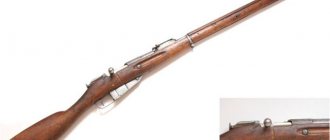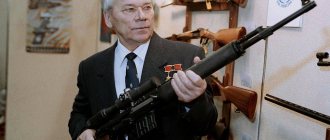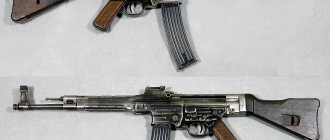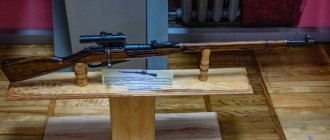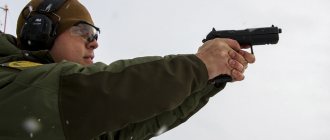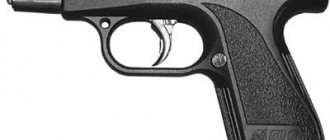Simonov Sergey Gavrilovich
Sergei Gavrilovich Simonov
Sergei Gavrilovich Simonov is a major Soviet designer of small arms. Honored Inventor of the RSFSR (1964), Hero of Socialist Labor (1954), twice laureate of the Stalin Prize of the first degree (1942, 1949).
Biography
Born on September 22 (October 4), 1894 in the village of Fedotovo, now the Vladimir region, in a family of peasants.
Graduated from 3rd grade of a rural school. From the age of 16 he worked in a forge. In 1915, he went to work as a mechanic at a small factory and completed technical courses. In 1917, he began working at the Kovrov plant (currently OJSC V.A. Degtyarev Plant ) as a mechanic. He took part in the refinement and debugging of the first Russian Fedorov assault rifle. Member of the CPSU(b)/CPSU since 1927.
Since 1922 - master, then senior master. Since 1929 - head of the assembly shop, designer, head of the experimental workshop. In 1922-1923 designs a light machine gun and an automatic rifle under the leadership of V. G. Fedorov and V. A. Degtyarev. the Simonov automatic rifle (ABC-36) was introduced and in 1936 adopted by the Red Army
In 1932-1933 he studied at the Industrial Academy.
With the beginning of the Great Patriotic War, Simonov and the enterprise were evacuated to Saratov. He paid great attention to the creation of light and heavy machine guns, but did not stop developing other weapons. In 1941 he developed a 14.5 mm anti-tank self-loading rifle (PTRS). By the end of 1944, Sergei Gavrilovich created the first samples of his famous SKS chambered for 7.62x39 mm based on a carbine, which he had developed as part of a competition for a new carbine back in 1940-1941, but which did not go into production due to the evacuation of factories .
S. G. Simonov (center) testing a new version of PTRS
In 1950–1970, S. G. Simonov worked at NII-61 (now the Central Research Institute of Precision Engineering TsNIITOCHMASH ) in the city of Klimovsk, Moscow region.
Died May 6, 1986. He was buried in Moscow at the Kuntsevo cemetery (site No. 10).
Biography
Born on September 22 (October 4), 1894 in the village of Fedotovo, now the Vladimir region, in a family of peasants.
Graduated from 3rd grade of a rural school. From the age of 16 he worked in a forge. In 1915, he went to work as a mechanic at a small factory and completed technical courses. In 1917, he began working at the Kovrov plant (currently OJSC V.A. Degtyarev Plant) as a mechanic. He took part in the refinement and debugging of the first Russian Fedorov assault rifle. Member of the CPSU(b)/CPSU since 1927.
Since 1922 - master, then senior master. Since 1929 - head of the assembly shop, designer, head of the experimental workshop. In 1922-1923 designs a light machine gun and an automatic rifle under the leadership of V. G. Fedorov and V. A. Degtyarev. In 1926, the Simonov automatic rifle (ABC-36) was introduced and in 1936 adopted by the Red Army.
In 1932-1933 he studied at the Industrial Academy.
With the beginning of the Great Patriotic War, Simonov and the enterprise were evacuated to Saratov. He paid great attention to the creation of light and heavy machine guns, but did not stop developing other weapons.
In 1950-1970, S. G. Simonov worked at NII-61 (now the Central Research Institute of Precision Engineering TsNIITOCHMASH) in Klimovsk, Moscow Region.
Died May 6, 1986. He was buried in Moscow at the Kuntsevo cemetery (site No. 10). [1] .
In the first edition of the Soviet Encyclopedic Dictionary (1979), in the article about S. G. Simonov, an inaccuracy was made: the year of death was incorrectly indicated as 1965.
Developments
- In 1936, the Simonov automatic rifle entered service with the Red Army.
- In 1941, he developed a 14.5-mm anti-tank self-loading rifle (PTRS), which was successfully used in the Great Patriotic War of 1941-1945.
- In 1944, the Simonov self-loading carbine was adopted by the Red Army. It was produced under license in many countries: China, Yugoslavia, East Germany, Czechoslovakia, Poland, etc. It was in service in 20 countries. In some countries (Bhutan, India, Albania, etc.) it is still in service today. Over the entire period, more than 2,000,000 samples have been produced. There are about 200,000 copies in personal use in the United States.
Simonov Sergey Gavrilovich
14.5 mm anti-tank rifle of the Simonov system ( PTRS )
Not many people erect monuments during their lifetime, only twice to Heroes. The famous weapons designer Sergei Gavrilovich Simonov had only one star of the Hero of Socialist Labor, but during his lifetime, for his great services to the Motherland, a monument was erected in the very center of Podolsk. And he himself was present at its opening. In the year of his ninetieth birthday, Sergei Gavrilovich was summoned to the Ministry of Defense and told: “A decision has been made to install your bust monument. Where do you think is the best place to install it?” Sergei Gavrilovich did not have to think long; he chose Podolsk. The years of his most successful work were associated with this city; here, during the war and post-war times, he created the best examples of small arms. With an anti-tank rifle designed by Simonov, Red Army soldiers defended Moscow from the Nazis. At the beginning of the war, the Germans were rapidly moving across our territory: our army, other than Molotov cocktails and grenades, had no effective means of fighting against their tanks. In July, Sergei Gavrilovich received the task of urgently developing an anti-tank rifle. And such a weapon was created within a few weeks. Already in the fall of '41 in Saratov (Simonov's design bureau was evacuated from Podolsk to this city), the production of a five-shot PTRS anti-tank rifle was literally mastered in the open air. This weapon played an important role in defeating the enemy. During the war years, a number of new, original models of small arms with high technical characteristics were also created. These are the SPS heavy machine gun, a light machine gun chambered for a rifle cartridge, and an assault rifle chambered for an intermediate cartridge of the 1943 model. And the SKS self-loading carbine, developed by Simonov in 1945, laid the foundation for the post-war small arms system and was adopted by the Red Army. The honor guard at the Mausoleum is armed with a carbine designed by S.G. Simonov. These weapons are still produced in our country and supplied abroad. A modified sample of the SKS is produced in China. Sergei Gavrilovich was the creator of the first Soviet automatic rifle adopted by the Red Army. It had no analogues in the world and was a significant achievement of domestic military technology. Its design provided for firing both single shots and bursts. It was adopted by the Red Army as a mass weapon. Our soldiers fought with this rifle against the White Finns in 1939 and 1940 and on the fronts of the Great Patriotic War. So a village boy with only a three-grade education became a famous designer. He was born exactly 110 years ago - on October 4, 1894 in a poor peasant family. He began working as an apprentice in a metalsmith's workshop in his home village of Fedotovo, Vladimir province. After completing vocational courses, he ended up at a military plant in Kovrov. Here he thoroughly studied weapons production and was soon appointed supervisor for assembling weapons models. Under his leadership, work was carried out to assemble weapons designed by Degtyarev. That's when he began to have ideas for creating his own weapons. In 1922, Sergei created his own design - a light machine gun. With this original design, distinguished by its simplicity and reliability, he established himself as a competent and extraordinary engineer. The machine gun was not put into service at that time, but Sergei Gavrilovich received official permission to develop his own designs for new types of weapons. He devoted a lot of effort to creating an automatic rifle, the first model of which was developed by him in 1926. It did not pass the tests, but this did not stop the designer. He persistently and purposefully continued to work on its improvement. Sergey, realizing full well that he lacks education to achieve success, works hard on himself. In 1930, he decided to enter the Military Engineering Academy. By that time, Simonov had already turned 36 years old, and he was accepted to study only until he was 35. He was given a condition: you will be accepted, but in this case you renounce all copyrights to your inventions in favor of the state. Simonov did not hesitate for a minute - his desire to learn was very great. And he was enrolled as a student at the Academy. But it didn’t take long to study - only six months; the country needed new, modern weapons. After creating and mastering the ABC automatic rifle, he worked hard on the design of the self-loading SVS. In all technical indicators it was superior to the F.V. Tokarev rifle developed in parallel, and in terms of survivability it was generally three times superior to it. But out of a desire to quickly rearm the army and, taking into account the fact that the Tokarev rifle had already passed field tests, Simonov’s more advanced design was not adopted for service. Sergei Gavrilovich was not a brawler, he always said that you just need to work hard, be completely dedicated to your work, and fame will find you. But in this case, he, contrary to all his life principles, sent a letter to the Udmurt regional party committee. Stalin somehow found out about the letter. And Simonov received at his disposal a special design bureau with a small production base in Podolsk. In 1957, Sergei Gavrilovich was persuaded to go to work at TsNIITM. Klimovsk already had well-established production, a testing facility was equipped, and competent specialists were working. Here Simonov developed several modifications of a self-loading sniper rifle, a 7.62mm machine gun, a 5.45mm machine gun, and other types of weapons. Over many years of devoted service to his beloved business, Simonov created a huge number of unique models of small arms, conducted many interesting studies, and made a huge contribution to the development of domestic weapons. The Museum of the Armed Forces displays more than 200 samples and modifications of his weapons. He paid great attention to the introduction of new models into production and the education of competent and responsible specialists. He charged everyone with his energy and dedication to his work. Could work around the clock. He was a happy father. He raised and raised eight children. He failed to implement many of his plans. I wanted to systematize all the available data on trigger mechanisms, but I didn’t have time. I was very upset that not all samples of his unique developments were adopted for service. This man did a lot for the country, he served his Motherland faithfully. And these are not big words. After all, Simonov worked at TsNIITM on a voluntary basis for a very long time, without receiving a salary, believing that since he had a pension, he no longer needed to pay a salary. The main thing for him was to be able to do what he loved. When he decided to move from Podolsk, buying a small house in Butovo, he simply left his apartment to the state. S.G. Simonov was awarded the title of Hero of Socialist Labor, awarded three Orders of Lenin, the Order of the October Revolution, Kutuzov II degree, Patriotic War I degree, two Orders of the Red Banner of Labor, the Order of the Red Star and many medals. Sergei Gavrilovich is a two-time State Prize laureate, Honored Inventor of the RSFSR. He carried out extensive government and public work and was a deputy of the Supreme Council of the RSFSR. Until the last days of his life, he was keenly interested in what was happening in the country and worked as hard as he could. The name of Sergei Gavrilovich Simonov will forever go down in the history of domestic and world weapons practice. His life and work are an inspiring example of selfless service to the people.
